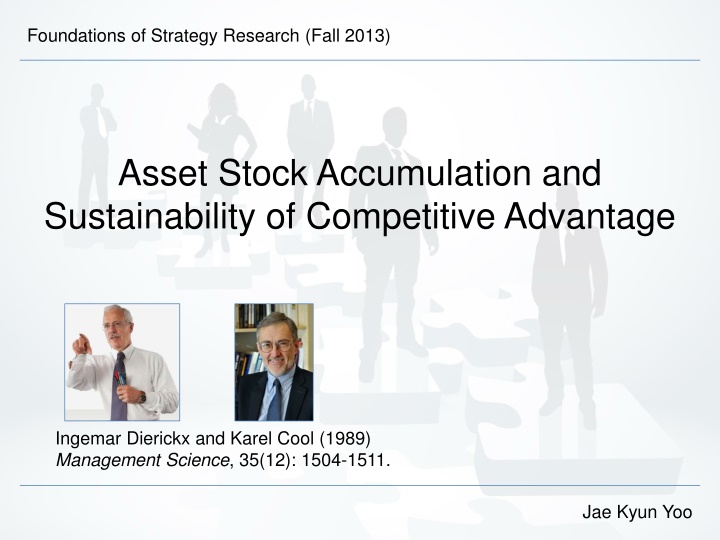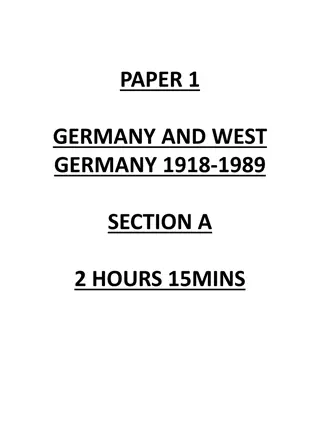
Asset Stock Accumulation for Sustainable Competitive Advantage
Explore the concept of asset stock accumulation and sustainability of competitive advantage in strategic management. Learn how firms can go beyond privileged market positions to achieve above-normal returns by focusing on unique skills and firm-specific assets. Discover the importance of accumulating non-tradeable assets like reputation, human capital, and R&D capability for long-term success.
Download Presentation

Please find below an Image/Link to download the presentation.
The content on the website is provided AS IS for your information and personal use only. It may not be sold, licensed, or shared on other websites without obtaining consent from the author. If you encounter any issues during the download, it is possible that the publisher has removed the file from their server.
You are allowed to download the files provided on this website for personal or commercial use, subject to the condition that they are used lawfully. All files are the property of their respective owners.
The content on the website is provided AS IS for your information and personal use only. It may not be sold, licensed, or shared on other websites without obtaining consent from the author.
E N D
Presentation Transcript
Foundations of Strategy Research (Fall 2013) Asset Stock Accumulation and Sustainability of Competitive Advantage Ingemar Dierickx and Karel Cool (1989) Management Science, 35(12): 1504-1511. Jae Kyun Yoo
Introduction Strategy literature focuses too narrowly on privileged product market positions as a basis for competitive advantage and above-normal returns (Gabel 1984; Wernerfelt 1984; Barney 1986). Opportunity cost of deployment of scarce assets to achieve market position needs to be assessed. Barney s strategic factor market : a market where the resources necessary to implement a strategy are required Firms may obtain above normal returns only when they have superior information, when they are lucky, or both. Firms should focus on their unique skills . Limitations, complementary framework, and guidelines for assessing sustainable competitive advantage. Ingemar Dierickx and Karen Cool (1989) Asset Stock Accumulation and Sustainability of Competitive Advantage Management Science, 35(12): 1504-1511.
Incomplete vs. Imperfect Factor Markets Barney s (1986) assumption: All required assets can be bought and sold. The implementation of a strategy may require assets which are non-appropriable. Successful implementation of a strategy often requires highly firm-specific assets. Complementary framework to gauge quasi rents generated through deployment of non-tradeable assets. Ingemar Dierickx and Karen Cool (1989) Asset Stock Accumulation and Sustainability of Competitive Advantage Management Science, 35(12): 1504-1511.
Accumulation of Asset Stocks With Non-tradeable Asset Deploy Without Non- tradeable Asset Build Examples: reputation of quality, firm specific human capital, dealer loyalty, R&D capability, etc. Strategic asset stocks are accumulated by choosing appropriate time paths of flows over a period of time. Ingemar Dierickx and Karen Cool (1989) Asset Stock Accumulation and Sustainability of Competitive Advantage Management Science, 35(12): 1504-1511.
Accumulation of Asset Stocks (cont.) stock of know-how at a particular moment in time bath-tub metaphor R&D spending While flows can be adjusted instantaneously, stocks cannot. depreciation of know-how A key dimension of strategy formulation may be identified as the task of making appropriate choices about strategic expenditures with a view to accumulating required resources and skills. Ingemar Dierickx and Karen Cool (1989) Asset Stock Accumulation and Sustainability of Competitive Advantage Management Science, 35(12): 1504-1511.
Sustainability of Privileged Asset Positions Imitation of Asset Stocks Time Depression Diseconomics strictly convex adjustment costs law of diminishing returns when one input, viz. time, is held constant MBA students accumulation of knowledge in a one-year program vs. a two-year program. Given rate of R&D spending over a particular time interval vs. twice the rate of R&D spending over half the time interval. Asset Mass Efficiencies success breeds success When asset mass efficiencies are important, building asset stocks starting from low initial levels may be difficult. Setting up a dealer network in a new geographic area. Ingemar Dierickx and Karen Cool (1989) Asset Stock Accumulation and Sustainability of Competitive Advantage Management Science, 35(12): 1504-1511.
Sustainability of Privileged Asset Positions (cont.) Imitation of Asset Stocks Interconnectedness of Asset Stocks New product and process developments find their origin in customer requests or suggestions -> difficult for firms without extensive service networks Asset Erosion All asset stocks decay in the absence of adequate maintenance expenditures. R&D know-how -> technological obsolescence Brand awareness -> consumer population not stationary, consumers forget Causal Ambiguity Accumulation asset stocks may be stochastic and discontinuous May stem from inability to identify some of the relevant variables as well as our inability to control them uncertain imitability Ingemar Dierickx and Karen Cool (1989) Asset Stock Accumulation and Sustainability of Competitive Advantage Management Science, 35(12): 1504-1511.
Sustainability of Privileged Asset Positions (cont.) Imitation of Asset Stocks Time Depression Diseconomics: decreasing returns to the fixed factor time Asset Mass Efficiencies: the initial level of an asset stock significantly influences the pace of its further accumulation Interconnectedness of Asset Stocks: the pace of an asset s accumulation is influenced by the level of other asset stocks Asset Erosion Causal Ambiguity Substitution of Asset Stocks Ingemar Dierickx and Karen Cool (1989) Asset Stock Accumulation and Sustainability of Competitive Advantage Management Science, 35(12): 1504-1511.
Conclusions Asset Stock Accumulation Quasi rents generated through nontradeable assets Asset stocks are built or accumulated through consistent time pattern of expenditures or flows. Time Compression Diseconomies Asset Mass Efficiencies Imitability Interconnectedness Sustainability of asset stocks Asset Erosion Sustitutability Causal Ambiguity Asset stocks are strategic when they are nontradeable, nonimitable, and nonsubstitutable. Ingemar Dierickx and Karen Cool (1989) Asset Stock Accumulation and Sustainability of Competitive Advantage Management Science, 35(12): 1504-1511.






















